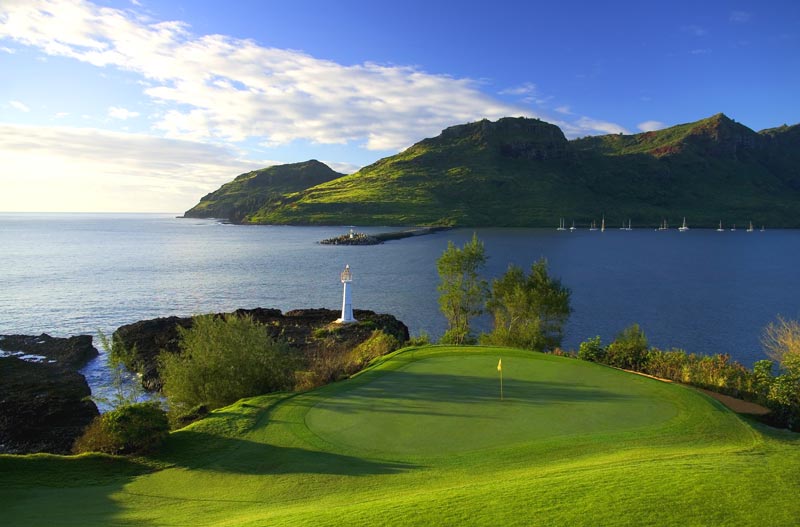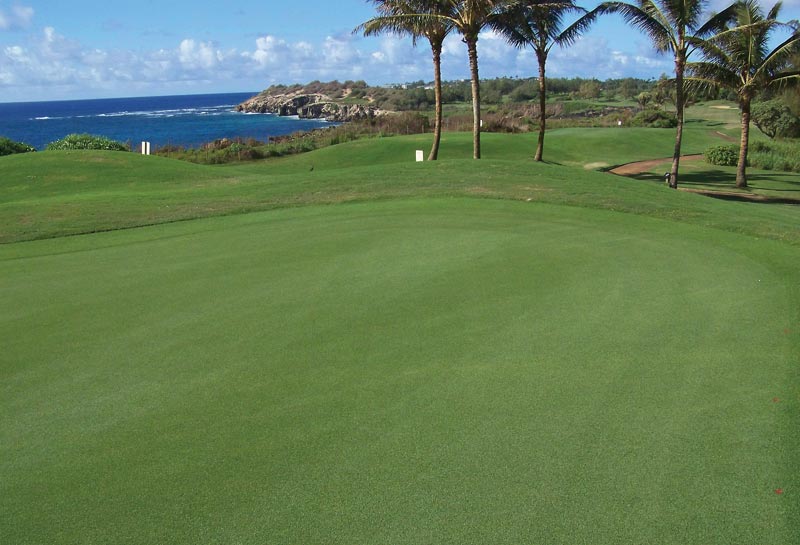
After being closed for three years, the Ocean Nine at Kauai Lagoons Golf Club on Hawaii’s Kauai Island has reopened as the Kiele Moana Nine. The renovations have given Kauai Lagoons the world’s longest stretch of golf holes bordering the ocean. Photo courtesy of Kauai Lagoons Golf Club
Stateside, golf course superintendents and directors of golf live by the maxim “Get ’er done.” In Hawaii, the saying is “e hana me” (let us work) or “i mua” (go forward). But they all boil down to the same philosophy: Do quality work, do it quickly and don’t lose your shirt in the process. Of course, how that’s done can translate into different solutions for different facilities. One size does not fit all when it comes to handling renovations — no matter how many similarities exist.
Let’s compare two resorts on Hawaii’s Kauai Island: Poipu Bay Golf Course, the former home of the PGA Grand Slam of Golf, located adjacent to the Grand Hyatt Kaua’i Resort & Spa, and Kauai Lagoons Golf Club, rated one of the top 50 resort courses in the world and part of Kauai. The two facilities are neighbors, located just 15 miles apart. They are both high-end resorts, catering to, among others, people who know golf and are familiar with playing the best courses.
Both are designed by famed course architects — Poipu Bay by Robert Trent Jones Jr. and Kauai Lagoons by Jack Nicklaus. Both flow dramatically alongside the Pacific Ocean, with Kauai Lagoons now boasting the longest stretch of ocean holes in the world. Being neighbors, they experience the same superb weather nearly every day of the year.
But in one point they differ, and that difference reveals why the two resorts reached opposite decisions on how to renovate their world-class 18-hole courses. The distinction is that Kauai Lagoons operated two 18-hole courses at the time of the renovations, while Poipu Bay only had one. Poipu Bay closed down its golf course entirely during construction. Kauai Lagoons renovated its famed Ocean Nine while remaining open, offering play on two other nines.
Making the right call
It was a no-brainer for Kauai Lagoons, according to Scott Ashworth, director of golf. Officials there decided to enhance the championship Kiele course, improving its Ocean Nine while turning nine holes of the “lesser” Nicklaus track, Mokihana, into villas and other resort housing. The result would be 27 holes of golf instead of 36.
Hyatt officials also determined that Poipu Bay needed a facelift. But they decided that instead of shortchanging their golfing patrons by closing a few holes at a time, they would bite the bullet and close it entirely for nine months.
“When it was proposed to close the golf course, we took into account how [poorly] the economy was going,” explains Craig Sasada, Poipu Bay’s director of golf. “We weren’t expecting a heavy year of visitors. So, if we were to take a hit, the feeling was: ‘Let’s do it now and do it right before reopening.
“We really had no choice in the matter. We’re only an 18-hole facility. If we closed a few holes at a time, it would give our guests an inferior product. Even if you were to charge half-price, you’d still get complaints.”
A few miles away, Ashworth stood firm by Kauai Lagoons’ choice: “It was absolutely the correct decision. Basically having the two golf courses gave us the ability to still stay open, albeit not to the level of what people were used to seeing with the Kiele championship course. Taking away the Ocean Nine, obviously we struggled a little bit. We reduced the rates considerably, probably by 30 percent, and definitely took a financial hit. Not only did we reduce the rates but we did not receive the play we were accustomed to.”
If Kauai Lagoons were an 18-hole facility like Poipu Bay, Ashworth said he would have made the same decision that Sasada had: “Absolutely. If I only had 18 holes, I would want to shut down all 18 and renovate it all at once.”
Both resorts have reopened their courses and have had time to evaluate the projects. Poipu Bay reopened Dec. 16, 2010, after being closed for nine months. Kauai Lagoons reopened in May 2011, after a three-year absence of its much-ballyhooed Ocean Nine, now called Kiele Moana Nine. Today, Kauai Lagoons offers the Kiele Moana Nine (Moana is Hawaiian for open ocean), the Kiele Mauka Nine (toward the mountain) and the Kiele Waikahe Nine (flowing stream).
The Poipu Bay way
Poipu Bay’s restoration included improvements to more than a dozen bunkers and tee boxes, as well as to its 21,000-square-foot clubhouse. But the main enhancement was the replacement of the existing greens and tee surfaces with seashore paspalum. It was a process undertaken entirely by superintendent Dean Uyehara and his crew.
Seashore paspalum is a warm-season turfgrass developed in the 1990s by Ronnie Duncan, Ph.D., at the University of Georgia. It requires less water and fewer chemicals than bermudagrass and tolerates salt-water spray and effluent or brackish water. Many superintendents consider it an excellent alternative to hybrid bermudagrasses because of its firmer playing surface and comparable texture and quality. It can also be cut lower than bermudagrass during the winter months.
Uyehara used the no-till method, which involves not removing the sod or reshaping the ground. Jones, the venue’s architect, whose Makai Golf Club at St. Regis Prince-ville on Kauai also switched from bermudagrass to seashore paspalum, signed off on the project. The no-till process includes killing the turfgrass over a period of time with a herbicide, aggressive aeration and verticutting to the point that the green is basically sand, and fumigating to prevent weeds. Uyehara says Poipu Bay was able to fumigate with methyl bromide because the company providing the product received government permission to use the supply he had left. Once that was done, he bought the seashore paspalum sprigs from a vendor on Oahu.

The seashore paspalum on the renovated tees and greens at Poipu Bay requires less water and fewer chemicals and is more tolerant of the salt-water spray from the ocean. Photo courtesy of Poipu Bay Golf Course
“The greens look absolutely pristine,” Sasada says. “Not only are they eco-friendly, but they provide a faster and more consistent roll for our players. Our guests will really notice the difference.”
He adds that the only people laid off during the construction process worked in the golf shop and guest services: “Our entire maintenance staff stayed at work. We saved money on that part and did it uninterrupted.”
Meanwhile, Poipu Bay officials launched a public-relations campaign to minimize any negative blowback from its guests.
“Starting six months ahead of time, we did a lot of PR releases, national pieces, announcing what we were going to do,” Sasada says. “It was publicized on our website and elsewhere, as much as we could so people would know ahead of time.”
The Kauai Lagoons way
“The No. 1 priority was getting that Ocean Nine open for us,” Ashworth says. “It is an amazing nine holes, and it drives our business.”
Nicklaus, who designed both 18-hole courses, came aboard to improve his favorite nine, declaring, “The new holes we are building are going to fit in nicely with what
golfers have come to expect from the Kiele Golf Course — great golf holes with beautiful ocean panoramic views.”
Weitz Golf International worked with Nicklaus and superintendent Rey Tacsiat to complete the project. Three new holes, including one ocean hole, were added, and the other six were renovated. Tacsiat, a member of the 36-man Kauai Lagoons maintenance staff for 20 years and a 12-year GCSAA member, says construction began in August and was completed in March. Weitz crews resurfaced the putting greens with TifEagle bermudagrass, replaced all the bunker sand and carried out Nicklaus’ design modifications.
Ashworth says there were advantages to renovating only nine holes: “With 27 holes, we had the flexibility to do it. We could choose to be financially responsible and not go out and spend all the money and do all 27 holes. We could stagger nine at a time, which is what we’re doing. And because each of the nines is separated from the others, you can work on one nine and golfers playing the others wouldn’t even know it.”
The negatives, he adds, are that “all 27 holes may not be of the same condition; also, from a construction standpoint, there are costs to mobilize a construction company multiple times.”
The resort plans to renovate the other two nines, but timing depends on the economy. Kiele opened in 1988 and Mokihana in 1989, and Ashworth points out, “irrigation and drainage only last so long, and sand changes.”
Lessons for other facilities
Asked whether he has any advice for colleagues considering closing their courses, either in part or entirely, Ashworth says: “When you’re looking at doing a renovation, you have to take everything under consideration. Right now, it’s a tough financial situation. You have to ask if a renovation is going to drive rounds and revenue for you. If it is, and you have the money to get it done, it’s great to be able to do, because it will give you a competitive advantage in the future.
“But every facility is different, and many can’t afford to shut down for nine months at a time. Nowadays, you can look at some of the amazing work that has been done, some of the renovations and the difference they make — even with irrigation and the spacing of the heads and (improved) pump stations to save money in the long run. It can all give you a competitive advantage if you can get in there and get the renovation done.”
The bottom line when considering how to handle your next major renovation can be summed up best by Hawaiians: “E mãlama pono” (take care).
Mark Leslie is a freelance writer based in Monmouth, Maine, and a frequent contributor to GCM.